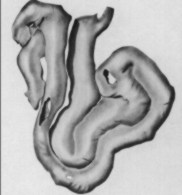The Graptovermida are extremely rare and poorly known Ordovician and Silurian organic microfossils. These enigmatic forms were described by Koz這wski (1949) as a provisional group of marine invertebrates in some way related to pterobranchs and graptolites. To date, graptovermids have been known from the early Ordovician of Poland (Koz這wski 1949) and 珸and, Sweden (Mierzejewski 1988). Recently, they were found
in the early Silurian of Gotland, Sweden (Mierzejewski & Kulicki, in preparation). The alleged graptovermids of Skevington (1965) were reinterpreted as rhabdopleurid zooidal tubes by Andres (1977) and Mierzejewski (1977).To the right is a specimen of Graptovermis intestinalis
Koz這wski, 1949, from the Tremadoc of Poland (from Koz這wski). 